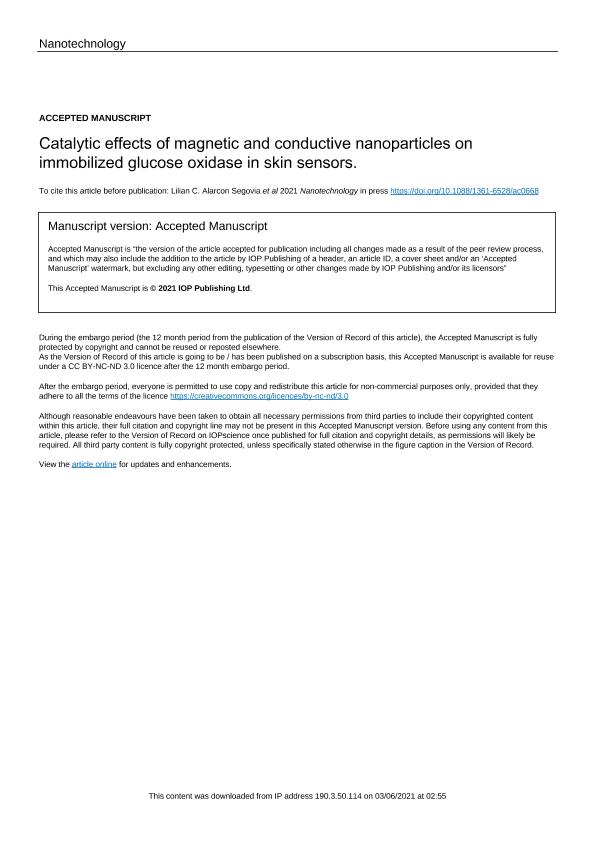Mostrar el registro sencillo del ítem
dc.contributor.author
Alarcon Segovia, Lilian Celeste

dc.contributor.author
Bandodkar, Amay J.
dc.contributor.author
Rogers, John A.
dc.contributor.author
Rintoul, Ignacio

dc.date.available
2022-10-18T11:00:52Z
dc.date.issued
2021-06-21
dc.identifier.citation
Alarcon Segovia, Lilian Celeste; Bandodkar, Amay J.; Rogers, John A.; Rintoul, Ignacio; Catalytic effects of magnetic and conductive nanoparticles on immobilized glucose oxidase in skin sensors; IOP Publishing; Nanotechnology; 32; 37; 21-6-2021; 1-22
dc.identifier.issn
0957-4484
dc.identifier.uri
http://hdl.handle.net/11336/173680
dc.description.abstract
Wearable skin sensors is a promising technology for real-time health care monitoring. They are of particular interest for monitoring glucose in diabetic patients. The concentration of glucose in sweat can be more than two orders of magnitude lower than in blood. In consequence, the scientific and technological efforts are focused in developing new concepts to enhance the sensitivity, decrease the limit of detection (LOD) and reduce the response time (RT) of glucose skin sensors. This work explores the effect of adsorbed superparamagnetic magnetite nanoparticles (MNPs) and conductive nanoparticles (CNPs) on carbon nanotube substrates (CNTs) used to immobilize glucose oxidase enzyme in the working electrode of skin sensors. MNPs and CNPs are made of magnetite and gold, respectively. The performance of the sensors was tested in standard buffer solution, artificial sweat, fresh sweat and on the skin of a healthy volunteer during an exercise session. In the case of artificial sweat, the presence of MNPs accelerated the RT from 7 to 5 s at the expense of increasing the LOD from 0.017 to 0.022 mM with slight increase of the sensitivity from 4.90 to 5.09 μAm M-1 cm-2. The presence of CNPs greatly accelerated the RT from 7 to 2 s and lowered the LOD from 0.017 to 0.014 mM at the expense of a great diminution of the sensitivity from 4.90 to 4.09 μAm M-1 cm-2. These effects were explained mechanistically by analyzing the changes in the concentration of free oxygen and electrons promoted by MNPs and CNPs in the CNTs and its consequences on the the glucose oxidation process.
dc.format
application/pdf
dc.language.iso
eng
dc.publisher
IOP Publishing

dc.rights
info:eu-repo/semantics/openAccess
dc.rights.uri
https://creativecommons.org/licenses/by-nc-sa/2.5/ar/
dc.subject
BIOMATERIALS
dc.subject
BIOSENSORS
dc.subject
DIABETICS
dc.subject
DIAGNOSTICS
dc.subject
INTEGRATED ELECTRONICS
dc.subject
NANOGOLD
dc.subject
NANOMAGNETITE
dc.subject.classification
Otras Nanotecnología

dc.subject.classification
Nanotecnología

dc.subject.classification
INGENIERÍAS Y TECNOLOGÍAS

dc.title
Catalytic effects of magnetic and conductive nanoparticles on immobilized glucose oxidase in skin sensors
dc.type
info:eu-repo/semantics/article
dc.type
info:ar-repo/semantics/artículo
dc.type
info:eu-repo/semantics/publishedVersion
dc.date.updated
2022-09-20T10:51:57Z
dc.journal.volume
32
dc.journal.number
37
dc.journal.pagination
1-22
dc.journal.pais
Reino Unido

dc.journal.ciudad
Londres
dc.description.fil
Fil: Alarcon Segovia, Lilian Celeste. Consejo Nacional de Investigaciones Científicas y Técnicas. Centro Científico Tecnológico Conicet - Santa Fe. Instituto de Matemática Aplicada del Litoral. Universidad Nacional del Litoral. Instituto de Matemática Aplicada del Litoral; Argentina
dc.description.fil
Fil: Bandodkar, Amay J.. Northwestern University; Estados Unidos
dc.description.fil
Fil: Rogers, John A.. Northwestern University; Estados Unidos
dc.description.fil
Fil: Rintoul, Ignacio. Consejo Nacional de Investigaciones Científicas y Técnicas. Centro Científico Tecnológico Conicet - Santa Fe. Instituto de Desarrollo Tecnológico para la Industria Química. Universidad Nacional del Litoral. Instituto de Desarrollo Tecnológico para la Industria Química; Argentina
dc.journal.title
Nanotechnology

dc.relation.alternativeid
info:eu-repo/semantics/altIdentifier/url/https://iopscience.iop.org/article/10.1088/1361-6528/ac0668
dc.relation.alternativeid
info:eu-repo/semantics/altIdentifier/doi/http://dx.doi.org/10.1088/1361-6528/ac0668
Archivos asociados
